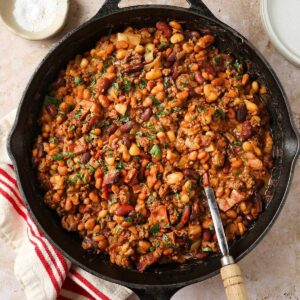Pav Bhaji is one of Mumbai’s most iconic street foods—a buttery, spicy vegetable mash served with soft, toasted buns. Originally created as a quick, nutritious lunch option for Mumbai’s textile workers in the 1850s, this dish has become a beloved staple across India and in Indian kitchens worldwide.
What makes pav bhaji special is its vibrant color, rich aroma, and bold flavors. It’s a perfect blend of comfort and spice, offering a satisfying texture from mashed vegetables and a punchy flavor from a special spice mix called pav bhaji masala. Whether it’s a family dinner, weekend treat, or party snack, pav bhaji is always a crowd-pleaser.
Ingredients
For the Bhaji (Vegetable Mash)
-
2 tbsp butter (plus extra for serving)
-
1 tbsp oil
-
1 cup chopped onions (about 2 medium)
-
1 tbsp ginger-garlic paste
-
2 cups chopped tomatoes (about 3 medium)
-
1 cup boiled and mashed potatoes (2 medium)
-
1 cup boiled green peas
-
1 cup chopped capsicum (bell pepper)
-
1 cup chopped cauliflower
-
1½ tsp pav bhaji masala
-
1 tsp red chili powder (adjust to taste)
-
½ tsp turmeric powder
-
Salt to taste
-
1–2 green chilies, finely chopped
-
Water (as needed to adjust consistency)
-
Fresh coriander leaves for garnish
-
Juice of half a lemon
For the Pav (Buns)



-
4 pav buns (or dinner rolls)
-
2 tbsp butter
-
A pinch of pav bhaji masala (optional, for toasting)
Optional Toppings
-
Finely chopped onions
-
Lemon wedges
-
Extra butter
Substitutions
-
Vegan: Use plant-based butter or oil.
-
Low-carb: Replace potatoes with mashed pumpkin or turnips.
-
Gluten-free: Serve with gluten-free bread or rice instead of pav.
Step-by-Step Cooking Instructions
1. Prep the Vegetables
-
Boil potatoes, peas, cauliflower, and carrots (optional) until soft.
-
Mash them lightly and set aside.
2. Make the Bhaji
-
Heat butter and oil in a large pan or tawa.
-
Add chopped onions and sauté until translucent (about 3–4 minutes).
-
Stir in ginger-garlic paste and green chilies; cook for 1 minute.
-
Add chopped tomatoes and cook until soft and pulpy.
-
Add turmeric, red chili powder, and pav bhaji masala.
-
Mix in the mashed vegetables and capsicum.
-
Add about ½ cup water to adjust consistency.
-
Use a potato masher or the back of a ladle to mash everything together while cooking.
-
Simmer for 10–12 minutes, stirring occasionally. Add more water as needed.
-
Finish with lemon juice, fresh coriander, and a dollop of butter.
3. Toast the Pav
-
Slit the pav buns horizontally (but not all the way through).
-
Heat butter on a flat pan, sprinkle a pinch of pav bhaji masala, and toast the buns until golden.
Common Mistakes to Avoid
-
Using raw vegetables: Always boil or steam them first for smooth mashing.
-
Skipping the masala: Pav bhaji masala is essential—don’t substitute with garam masala.
-
Overwatering: Add water gradually to avoid a runny bhaji.
Pro Tips and Cooking Techniques
-
Use a flat griddle (tawa) for authentic texture and even cooking.
-
Mash as you cook: Constant mashing enhances texture and flavor absorption.
-
Caramelize onions slightly for deeper sweetness.
-
Butter is king: Don’t skimp—pav bhaji is meant to be rich and indulgent.
Variations and Customizations
-
Jain Version: Skip onions, garlic, and root vegetables like potatoes; use raw bananas or bottle gourd.
-
Cheese Pav Bhaji: Add shredded cheese on top of hot bhaji for a fusion twist.
-
Paneer Pav Bhaji: Mix in grated paneer for added protein.
-
Spicy Version: Add chopped green chilies or increase chili powder for more heat.
-
Healthier Twist: Use olive oil, reduce butter, and add more fibrous veggies like spinach and beans.
Serving Suggestions
-
Garnish with chopped onions, a lemon wedge, fresh coriander, and a cube of butter on top.
-
Serve hot with butter-toasted pav buns on the side.
-
Pair with buttermilk, mango lassi, or a simple cucumber salad for a balanced meal.
-
For parties, serve it buffet-style with a toppings bar.
Nutritional Information (Per Serving – Approx.)
-
Calories: 400–450 kcal
-
Protein: 8–10 g
-
Carbohydrates: 50–60 g
-
Fats: 18–20 g
-
Fiber: 6–8 g
-
Sugars: 5–6 g
Note: Nutritional values may vary based on ingredients and portion sizes.
Frequently Asked Questions (FAQs)
Can I make pav bhaji in advance?
Yes! You can refrigerate the bhaji for up to 3 days or freeze for 2 weeks. Reheat with a splash of water on a pan.
Why is my bhaji too watery?
You may have added too much water or didn’t mash enough. Simmer longer to thicken.
What is pav bhaji masala made of?
It’s a spice blend of coriander, cumin, fennel, dry mango, black pepper, and more. Available in Indian stores or online.
Can I use a pressure cooker or Instant Pot?
Absolutely! Pressure-cook the veggies and follow the rest of the recipe on sauté mode.
Closing Thoughts
Pav bhaji isn’t just a dish—it’s an experience. Its rich aroma, sizzling butter, and spicy kick make it one of India’s most cherished comfort foods. Whether you’re trying it for the first time or making it for the hundredth, there’s always joy in every bite.



